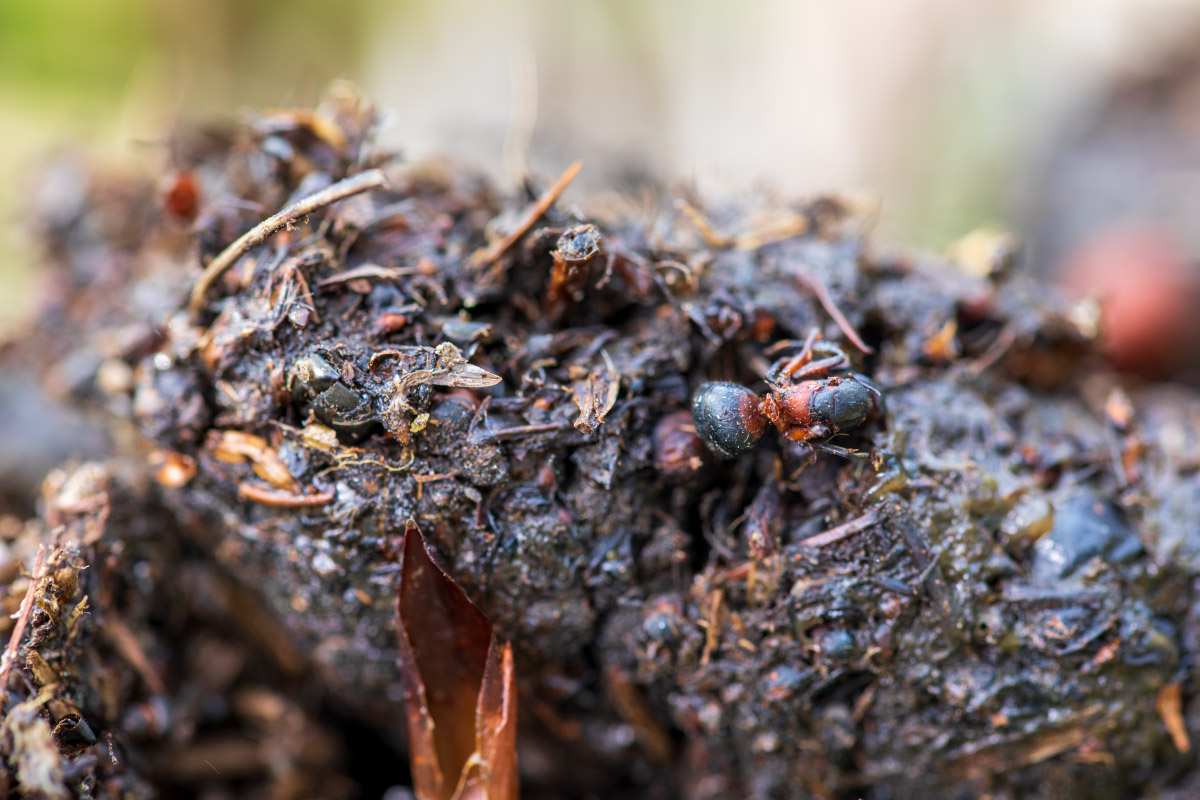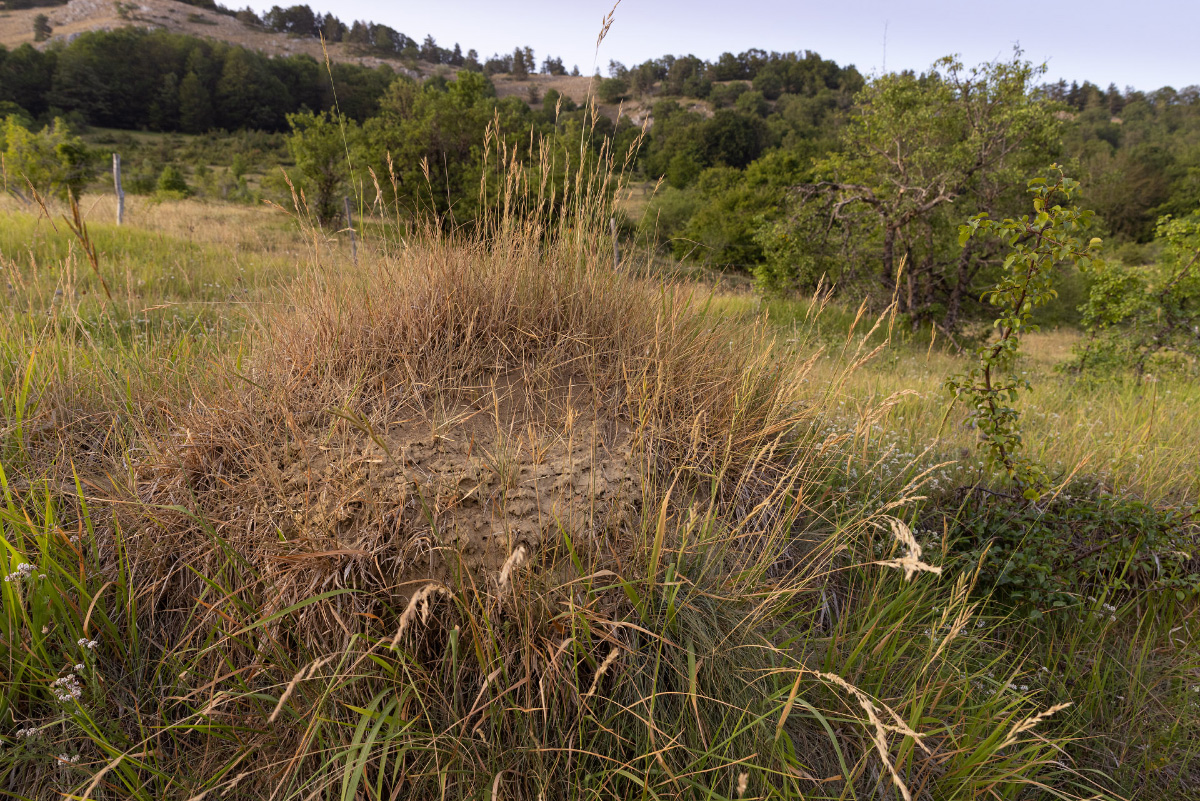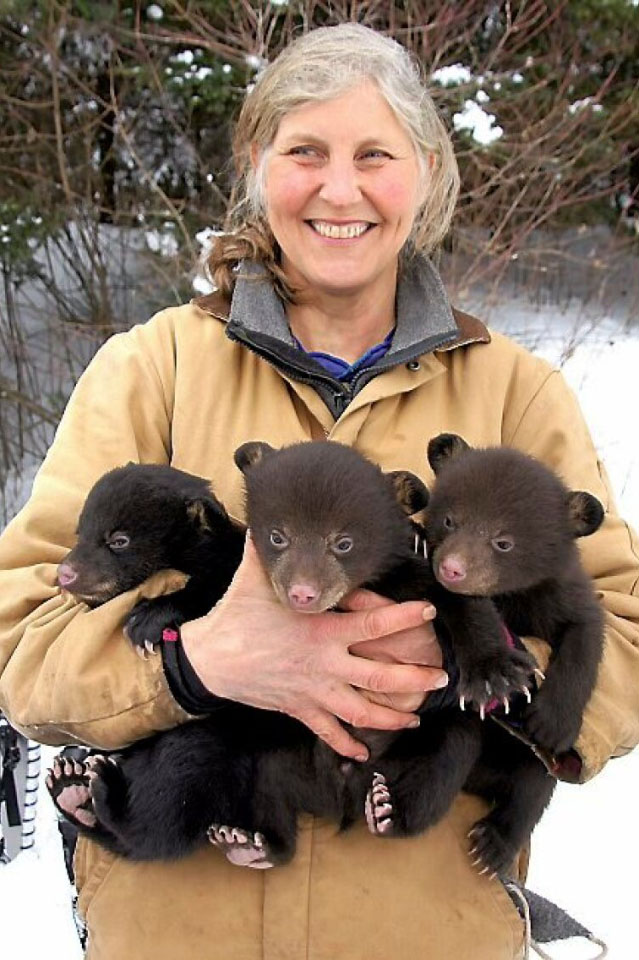The bear and the ant
True rulers of the Earth, ants weave the fabric of existence for dozens of species of plants and animals, including bears.
On a mid-May day when the air is humid and hot, you only have to lower your viewpoint to a few millimetres from the ground to enter an incredible kingdom, the realm of ants.
When temperatures rise about 20 degrees centigrade, turmoil breaks out, both above and below ground. Ants swarm on the top of boulders, among the tufts of grass and bushes, on the mounds of earth, through the dead leaves on the forest floor and over the roots and bark of the trees. In just a few square metres, millions of ants in columns explore the territory in search of caterpillars, spiders, seeds and fruits, while others tend and “milk” aphids, or fight and enlist allies to defend their colony. In the shelter of the nests, the workers of a single colony build and defend the nest and take care of the queen mothers, cleaning and feeding them, together with the eggs they lay, which will become larvae, then pupae and finally adults. The future of the colony in fact depends on the birth of new virgin queens and winged males. The life of the colony revolves around a single objective: to reproduce, defend and propagate itself. An ant colony can be considered as a self-sufficient macro-organism and its strength lies in the ants’ ability to create strong links and complex social arrangements. Each ant has its own role within a hierarchical structure organised into castes. Unity is strength and each colony has its own unique identifying odour that strengthens the bonds. When the breeding season arrives from late June onwards, swarms of virgin queens and winged males emerge from the nests and swarm in the air to mate. The queens that survive toads, spiders, birds and attack by other territorial ants tear off their wings and either look for a place to dig a new nest or return to their original nests. The males, on the other hand, die within hours, leaving behind thousands of descendants.
Just 20 square metres of land can contain dozens of nests of different ant species. Each of these contains thousands of insects, an opportunity not to be missed for bears.
To the untrained eye, all ants look the same, but this is not the case. In recent years, detailed analysis of the ant remains found in bear droppings has revealed that bears feed on more than forty different species. The richness of the Park’s environments (grasslands, clearings, scrub and forests) provides an ideal environment for the life of these insects and it is home to well over eighty different species. Ants build below and above ground “skyscrapers” that can reach several metres in depth and width. The workers are formidable engineers, digging nests vertically and moving between the different levels, transporting the future generations to the best “apartments” This is a strategy to cope with possible variations in environmental conditions that could compromise the reproductive success of the colony, such as temperatures that are either too cold (below 10 degrees) or too hot (above 30 degrees). The nests are, in fact, conceived to ensure the right temperature and humidity conditions needed to raise the broods. The ants concentrate their nests under generally flat rocks, partly buried in the ground and well exposed to the sun. By warming up quickly, the stones create the right temperature to “wake up” the colony, while the warmth and food provided by the workers make the larvae grow faster. Other species construct mounds of earth known as anthills which may include leaves, grass stems and conifer needles. Reaching as much as a metre in height, the anthills are full of interconnecting galleries and chambers. Then there are other species that build their nests in pre-existing cavities in usually dead or dying trees or trunks.
Foragers of Lasius fuliginosus patrol their territory searching for foods to bring in their nests built inside cracks or holes in old beech trees.
Between June and July, bears spend a great deal of time rummaging under rocks, dead trees or mounds of earth in search of the ant nests that teem with adult insects and their broods during these months.
Between June and July, more than 36% of a bear’s diet is provided by ants. During particularly hot and dry years, almost half the diet may consist of ants alone. These values are comparable with those of other populations of both brown and black bears, but are among the highest documented for brown bears in Europe. Consumption peaks between late June and mid-July, coinciding with the presence of the broods (eggs, pupae and larvae) in the nests, but bears may consume adult ants all year round. They rely on their claws to gain access to the nests, whether under a rock or inside a log or anthill. They lift rocks measuring as much as three square metres and weighing several quintals to scoop away the surface of the nests with quick paw strokes. If the ants are aggressive, the bears let them swarm over their legs, then lick them off, otherwise they lick the damaged surface directly. The workers usually take more than ten or so seconds to move the brood to safety in the depths of the nest, giving the bear the opportunity for a genuine raid. Along with the ants, however, bears also swallow soil debris and the leaves forming part of the nest, as is evident from close examination of bear droppings.

An experienced myrmecologist may identify ants recovered in the bear scats based on morphological differences of the undigested remains of their heads, thoraxes, and abdomens.
Why do bears eat ants? Ants are rich in proteins, fats and very rare amino acids that bears lack, all essential nutrients for building body mass, growing and storing fat. Each ant can provide about 0.004 kilocalories and bears can consume even millions of kilocalories of ants per day. A few hours digging out nests and tipping stones can meet a large part of their energy needs. During the spring, adult bears need to replenish the protein reserves they may have lost during hibernation (bears can lose 20 to 40% of the weight accumulated in autumn), while cubs as young as 5-6 months old (born in the den) need them to grow.
In early summer, a bear is roaming among Juniper shrubs searching for ant nests. When they are under attack, the workers of Formica pratensis defend their colony by spraying formic acid from a distance of tens of centimeters.
Bears have only one philosophy of life: eat a lot with little effort. In the case of ants, they prefer to spend a long time over a few plentiful nests, or they may wander around lifting all the stones and logs they come across.
Bears feed mainly on five genera of ants. The Formica and Lasius genera occur in more than 70% of the droppings containing these hymenopterans. These are followed by Tetramorium (about 40%), Camponotus (about 24%) and Myrmica (about 20%), also the most abundant genera in the Park. Among the Lasius genus, bears are especially fond of the small honey-coloured yellow species. When bears find their nests, they feed on these alone. The ants form very large colonies, both above and below ground and very close together. The workers also produce a secretion, a sweet strong-smelling pheromone which seems to attract bears. When disturbed, these ants are also among the slowest to save their brood. Most ants of the Formica genus build visible mounds housing very large colonies, excellent pickings for bears, as they can thus eat for a long time without moving around too much, saving a great deal of energy. Species such as Formica pratensis and Formica sanguinea belonging to the Serviformica group dominate. The other genera, found everywhere in the Park, form smaller, or at least less “conspicuous”, colonies. The presence in the bear’s diet of ants of the Myrmica genus is curious, as they are very aggressive, bellicose insects with a sting and generally shunned by many mammals, including insectivores. But this does not seem to be the case with the Marsican bear. Bears in the Apennines prefer to feed mainly on ants living in open grasslands or in areas of transition with forests. On the other hand, they consume very few species (in practice only two) of the ants that inhabit the beech forests and dig their nests in the wood. These are Lasius fuliginosus and Aphaenogaster subterranea. From one to six different ant species have been found in bear droppings, depending on the bears’ feeding strategy.
Millions of years of evolution have enabled these insects measuring just a few millimetres to regulate the life of entire ecosystems.
Yellow Lasius ants build their colony by parasitising and enslaving other Lasius ants until they gain the upper hand. In the Apennines, these insects dig their nests under rocks, but they also build voluminous mounds of soil and plant debris. They are experts at farming aphids and feed almost exclusively on sugary substances obtained from the excretions of these insects. Aphids in fact feed on the sugary sap of plant phloem, sucking it up through their needle-like proboscis. The ant approaches with its antennae and forelegs and the aphid responds by emitting a drop of liquid from its anus. The ant reacts by licking the honeydew and passes from one aphid to another, feeding from them until its abdomen swells. Satiated, it returns to the nest and regurgitates the honeydew into the mouths of its companions. These ants are genuine farmers and the aphids are farmed at a distance, or even in the nest itself. This type of relationship is known as mutualistic symbiosis or trophobiosis: food in exchange for protection.
Lasius fuliginosus is the “master” of the beech forest. It is a very territorial species and defends itself by preying on enemy ants. The foragers patrol exclusive areas up to hundreds of square metres in size and including dozens of trees, which in turn are used both to farm aphids and as primary and secondary nests. The workers build their nests inside cracks or holes in old beech trees. The nests seem to be constructed from cardboard, but they are actually made of wood macerated and cemented by the ants’ saliva. They forage non-stop day and night, forming conspicuous columns that swarm from tree to tree. But they don’t always manage to come back with a mouthful, as there is a genuine confidence trickster lying in wait. This is a beetle in the Amphotis genus, adept at acting like a “sister worker” in search of food. The beetle drums the ants’ heads and stimulates regurgitation. When the ants realise the deception, they attack, but the beetle withdraws its legs and becomes practically untouchable.
In the sequence: Lasius giallo spp., Lasius Fuliginosus, Formica pratensis, Tetramorium spp.
Formica pratensis is easily recognisable for its red nuances and the anthills measuring up to several metres in diameter constructed with juniper needles, earth and grass. They are known to be “more specialised predators” than other ants, but above all they have a very effective defence system. When they feel under attack, they launch themselves at the enemy, rear up on their hind legs and spray formic acid from a distance of tens of centimetres. Ants can in general be likened to armed battalions, with every detail of a complex strategy of attack and defence stored in their genetic code. The colony comes first.
Compared to the Lasius and Formica genera, Tetramorium ants form smaller colonies dominated by a single queen. These ants prey on spiders and other insects, as well as feeding on sugary substances. They have also come to an “understanding” with the caterpillar of a lycaenid butterfly in the Polyommatus genus. With no intrinsic protection against predators and the wasps that can parasitise it by depositing their eggs inside its body, the caterpillar has developed a stable form of symbiosis with these ants. Special glands enable the caterpillars to produce a liquid rich in sugars and amino acids which the ants love. This prompts them to protect the caterpillars by surrounding them with walls of earth or hiding them in their own nests.
Each year, regardless of age and gender, bears in the Apennines consume ants on a constant basis. A staple in the bears’ diet, ants are essential for the growth and survival of the cubs. Females and cubs are smaller than adult males and can therefore put on weight more quickly for the same number of ants consumed. Ants can also be found everywhere, so they do not attract several bears to the same spot, as for example a deer carcass might. This means that females with young can find quiet, safe places away from adult males, which in the spring can be very dangerous for newborn cubs.

A voluminous earthen mound built as a nest by workers of Lasius yellow ants.
Minnesota and the Apennines, two countries, two bears, same story
American bear expert Karen Noyce explains the importance of ants for black bears in Minnesota. “In northern Minnesota – Karen explains with contagious enthusiasm – black bears eat a surprising amount of ants, especially when compared to other black bear populations. From June to mid-July, more than 50% of their diet consists of ants, including adults, larvae and pupae. Ants are crucial for bears she studied. Karen explains to us that when they come out of their dens, young bears, females that gave birth the previous year and those that have just given birth, need to get their strength back. Young bears especially need to use all their time to build up bones and muscles. As the months progress, the grass becomes increasingly low in protein and the fruit season is far away, but that’s when protein and fat rich ants become active and reproduce. “Right on cue! – Karen explains –”At least in our study area, thanks to the ants, the young bears continue to grow and don’t lose weight as happens in other study areas.” This is not the end of the story. When Karen started to study the diet of black bears in northern Minnesota, her biggest surprise was that of all the ant species she and her collaborators observed swarming above ground in the woods, virtually none were present in the bears’ droppings. The bears fed exclusively on a small yellow ant called Lasius umbratus, but there were no apparent traces of this species anywhere in their study area. Hence their curiosity and desire to find an answer. Yellow ants lead a more discreet and secluded life than other ants. They live deep underground and feed mainly on honeydew produced by insects, the aphids the ants themselves raise. As Karen explains with a smile: “Once you’ve found the nest (that is if you do manage to find it), you’ll see thousands of ants with their larvae. They’re calm and don’t escape. At most they release a defensive substance that smells like citronella and makes them perhaps even more attractive or detectable. An easy, nutritious meal that doesn’t escape the bear’s nose”. The same thing happened to researchers from the University of Rome, because Apennine bears also find yellow ants irresistible: Says Maurizio Mei of La Sapienza University: “The only time I really managed to see large numbers of them all together was during a nuptial flight. They flew right over my head.”

Bears in the Apennines eat ants all year round. Ants are a rich, constant and important source of nutrients for the growth and survival of this population and also the resource that will perhaps be least affected by climate change: a guarantee for the future of the bear.


